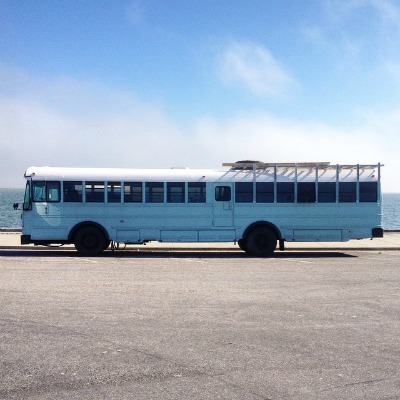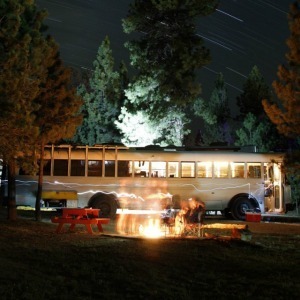ESTEEM 2015 alumn Rory Dunne gives his take on how taking on a bus renovation is similar to starting a company. Rory will be taking a job with Deloitte following his time on the “Serendipitibus”.
As with any entrepreneurial endeavor, this one began with the voicing of a crazy idea to some trusted confidants. On a summer break drive to a friend’s house, we were discussing the kinds of possibilities that might give us something to look forward to after the grueling demands of the Master’s program that lay ahead of us. A school bus passed us by and so the idea was born. Over the next year, we would buy and renovate a school bus into an RV so that we could see the United States.
1. The Learning Process

Like a blog-post, any exercise in innovation has a beginning, middle and end. The difference between the two is that during a blog-post, you usually have a good idea of the direction in which you are going and how you are going to get there.
Throughout the process of conceptualizing and creating the ‘SerendipitiBus’, we could never once claim that we were in our comfort zone. Around every corner lay a new challenge for our unqualified team. Just when the crew reached a point of inflection and we began to sink into a rhythm of familiarity, the task would be complete, moving us on to an entirely new phase of the project.
Even when you do learn, it is far removed from the textbook heavy, examinable kind of learning that we are familiar with through conventional education. Oftentimes, you learn by doing and by doing wrong! The idea that mistakes offer useful lessons is something we are all aware of, but becoming accustomed to their almost daily occurrence takes getting used to.
2. Resourcefulness
Having only graduated in May, we haven’t even yet qualified for the illustrious title of ‘young professionals’ and the benefits of the salary that supports the brunch-laden, frivolous lifestyle of first-time pay-checkers. This necessitated a careful approach to both the raising and spending of funds that would allow our ideas to enter into the realm of reality.
Determined not to compromise on the quality of our final product, we budgeted carefully, planned our resources and compared prices to ensure that we remained within the confines of our predefined budget. Where labor was concerned, every task was carried out by a combination of our team and generosity of our friends and family (Shoutout to Mr. & Mrs. Machesney, Mr. & Mrs. Lyne, Mr. & Mrs. Flanagan, Mike Flanigan, Charley Berno, Andy ‘Kenneth’ Kienlan, Christopher Cali, Vinh Lam, Frank Dunne, and John Vernon for all of the help – We owe you guys!).

For fundraising, we did what is required of any start-up – craft and communicate a message that appeals to the better nature of those in a position to fund you. After a year of thorough preparation through ESTEEM classes on marketing, pitching and emotional intelligence, this concept became second nature to us. Our project provided the perfect opportunity to convert this theory into practice and luckily, in this way, we were able to appeal to multiple sponsors, including a very generous gift from the ESTEEM program and McDonald’s.
3. Hours & Sacrifices
Any entrepreneur that has crossed the coals of enterprise will tell you of the late-nights, the early mornings and the events sacrificed in pursuit of their dream. In fact, our classmates in ESTEEM might have likened us to the kind of reclusive hermits that dot the streets of Silicon Valley and use every opportunity to further their work.
4. Working in a Team

With something as unconventional as a bus renovation, and with a team as inexperienced in such matters as we were, we certainly wore many unfamiliar hats. By morning, you might be an amateur plumber and by the afternoon, you may have graduated to the role of welding assistant. Without doubt, this versatility prepares us for the demands of the life of an entrepreneur where any demand can be placed on you, at any time.
It seemed that members of the team naturally began gravitating towards positions where they could perform their best. In the final week, when preparations were at their most intense, those who were better fabricators fabricated while the painters painted. Not only was our productivity higher, but our team was happier as a result. While this strength-based approach to carrying out work is experiencing a surge of popularity in the workplace, seeing it evolve in such a natural, and effective, way was as gratifying as it was informative.
5. Planning
Each step of the process, from design through to the build, required meticulous planning. Thanks to Judy Lewandowski’s class on project management, we were able to employ some useful techniques that maintained a steady pace of progression throughout the project. As with the other lessons from ESTEEM, this contextualization of our education in reality, from product delays to scheduling conflicts, was extremely useful.
6. The Rule of 2X

On several occasions during our time in the ESTEEM program, we had the pleasure of speaking with a successful founder and current angel investor, Jim Hunt. One of his many pieces of wisdom that resonated with our class was his take on start-up planning. For this he said, always allow twice as much time and/or twice as much money as planned. Certainly, our group now sees the merits of such a statement from the tough perspective of experience.
We have been immeasurably fortunate to have been in a position to have gone through with this idea. Our thanks go out to everyone that has helped us get to this point. To our families, friends, sponsors, suppliers, the staff of the ESTEEM program and all of the lovely people we met along the way, we are forever grateful.
If you enjoyed this post, you can learn more by following our adventure on our Facebook page, our Instagram, or our website.